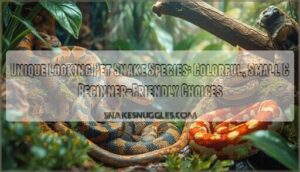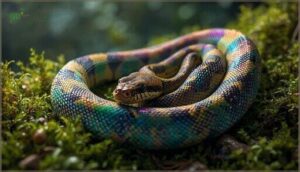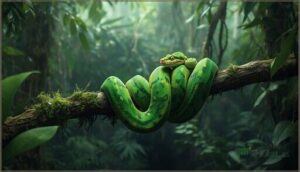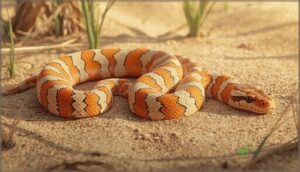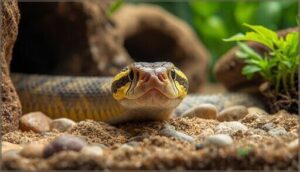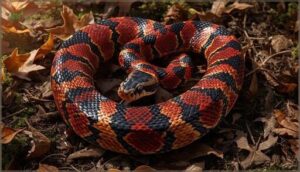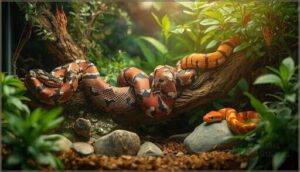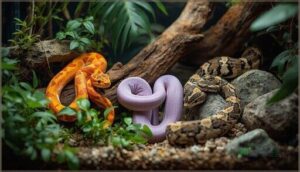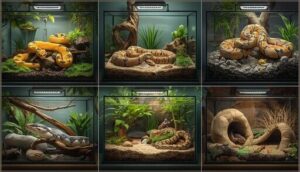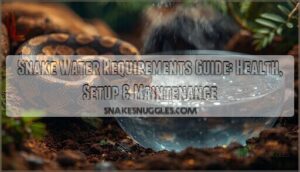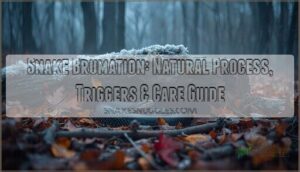This site is supported by our readers. We may earn a commission, at no cost to you, if you purchase through links.
If you think all pet snakes blend into the background, prepare to have your expectations rattled. Some species sport scales that shimmer like spilled oil, while others flash neon stripes or wear a snout that’s upturned like a cartoon villain.
The domain of unique-looking pet snake species is packed with dazzling colors, wild patterns, and personalities that range from bashful to bold.
Whether you’re drawn to the rainbow glow of a Brazilian boa or the playful antics of a hognose, there’s a snake out there that’ll make you rethink what “exotic” really means—and maybe even tempt you to bring one home.
Table Of Contents
- Key Takeaways
- Most Unique-Looking Pet Snake Species
- Colorful Pet Snakes for Enthusiasts
- Beginner-Friendly Unique Snakes
- Small and Manageable Unique Snakes
- Care Considerations for Unique Pet Snakes
- Frequently Asked Questions (FAQs)
- How do I handle a new pet snake?
- What snake species are best for beginners?
- Can pet snakes bond with their owners?
- How often should snakes be fed?
- What equipment do I need for snakes?
- Are unique pet snakes safe around children?
- How much do rare snake species usually cost?
- What permits are needed for exotic snakes?
- Do unique snakes require special veterinary care?
- Can unique pet snakes coexist with other pets?
- Conclusion
Key Takeaways
- Unique pet snake species like Brazilian Rainbow Boas and Green Tree Pythons dazzle with colors and patterns that make them true showstoppers.
- Beginner-friendly snakes such as corn snakes, ball pythons, and Kenyan sand boas combine striking looks with gentle temperaments and easy care.
- Proper enclosure setup, temperature, humidity, and feeding routines are essential for keeping these exotic snakes healthy and happy.
- Rare morphs and color variations can make some pet snakes expensive, with prices reaching thousands of dollars for the most exclusive types.
Most Unique-Looking Pet Snake Species
If you’re after a pet snake that’s unlike any other, you’re in the right place. Some species look so unusual, they’ll have your friends doing double takes.
Let’s check out a few of the most eye-catching options you can actually keep at home.
Brazilian Rainbow Boa — Iridescent Scales
Under soft light, the Brazilian Rainbow Boa dazzles with scale iridescence—a true living rainbow. Its iridescent scales shimmer in kaleidoscopic colors right after shedding, making this Unique Pet Snake Species a showstopper.
With morph variations and a captive lifespan up to 30 years, it thrives if you nail its humid habitat needs. Their coloration results from microscopic scale ridges that refract sunlight. Trade regulation keeps their wild beauty protected.
Green Tree Python — Vibrant Emerald Color
If the rainbow boa is all shimmer, the Green Tree Python is pure emerald magic. This arboreal snake starts life in wild yellow or red, then shifts to green—talk about a Color Change! Its Habitat Needs call for vertical space and humidity. Feeding Habits? Nocturnal rodent hunts. From Thermoregulation to Reproduction, it’s an exotic charm that’s hard to forget.
The snake’s prehensile tail aids in tree climbing abilities and catching prey.
Kenyan Sand Boa — Striking Orange Patterns
If emerald green isn’t your style, Kenyan Sand Boas bring a burst of orange to the party. Their Orange Morph Genetics create dazzling boa color variations, from tangerine to sunset.
These small pet snake options thrive in sandy habitats and show unique personalities—some burrow, some peek out curiously. With beginner-friendly care and reptile pattern evolution, they’re a true standout!
Western Hognose Snake — Upturned Snout
Western Hognose snakes steal the show with their adorable upturned snouts, perfect for digging through sandy soil. These beginner-friendly options show off unique personality with dramatic “play dead” acts and colorful snake morphs ranging from gray-tan to vibrant yellows.
Their docile temperament and fossorial lifestyle make hognose care surprisingly simple. You’ll need 4+ inches of substrate for their burrowing habits, and captive breeding has produced stunning varieties that’ll make your friends jealous!
Milk Snake — Bold Red, Black, and Yellow Bands
Milk snakes rock some of nature’s boldest fashion statements—those red, black, and yellow bands aren’t just eye candy, they’re striking mimicry of venomous coral snakes!
You’ll find stunning milk snake color patterns across their habitat range, from Pueblan milk snakes to countless colorful snake morphs.
Pattern genetics and captive breeding have created even more variations in these beginner-friendly options, making snake behavior observation endlessly fascinating.
Colorful Pet Snakes for Enthusiasts
If you’re drawn to snakes that look like living works of art, you’re in for a treat. Some species don’t just catch the eye—they stop people in their tracks with jaw-dropping colors and patterns that seem almost too vibrant to be real.
Some snakes dazzle with colors and patterns so vivid, they look like living masterpieces that turn heads instantly
Let’s explore a few colorful favorites that bring serious visual wow factor to any collection.
California Kingsnake — Dramatic Contrasts
If you’re after dramatic displays in a pet snake, the California Kingsnake delivers! These stunning serpents showcase bold color pattern variance—from jet-black bands to creamy whites and even vibrant yellows.
With over 50 unique snake morph genetics available through captive breeding, you’ll find everything from striped to banded patterns. Their habitat adaptation skills and straightforward feeding behavior make them remarkable beginner-friendly options for colorful snake patterns enthusiasts seeking unique personality.
Corn Snake — Diverse Color Morphs
You can’t beat corn snakes for sheer morph genetics variety—over 60 vibrant corn snake morphs exist in captivity! From Albino to Palmetto, these colorful snake patterns showcase striking snake color patterns and morphs thanks to ethical sourcing and thoughtful breeding practices.
Market popularity favorites like Lavender and Caramel combine stunning physical traits with docile temperaments. Whether you’re drawn to stripes or speckles, there’s a morph calling your name!
Ball Python — Unique Pattern Variations
Ball pythons hold the crown with over 4,000 pattern morph genetics variations in captivity as of 2023! Designer morph trends showcase combinations like Dreamsicle (Albino, Lesser, Piebald) and Sunset—truly stunning snake color patterns. Rare morph pricing reflects exclusivity: scaleless morphs can exceed $1,000 each in 2024, though scaleless morph issues require extra care.
Breeding new morphs means you’re joining a colorful snake revolution—discovering tomorrow’s must-have ball pythons today!
- Piebald morphs feature unique white patching (10-80%) that never repeats
- Banana morphs display high-contrast yellow and lavender snake patterns
- Mojave super form produces striking white coloration with blue eyes
- Spider morphs offer thin-lined dark patterning, but may have neurological concerns
Garter Snake — Striped Coloration
Garter snakes sport longitudinal stripes—usually yellow—that run the full length of their black, brown, or green bodies. Over 90% of these colorful snake patterns include this signature look! You’ll find five major striped morphs in some populations, from melanistic (all-black) to erythristic (red-tinted).
As beginner-friendly snake species go, garter snakes adapt brilliantly to diverse habitats while playing an essential ecological role controlling amphibian and insect populations.
| Feature | Details |
|---|---|
| Color Frequency | Melanistic morphs: 0-49% by location; Erythristic: 13% in some areas |
| Habitat Distribution | Grasslands, wetlands, forests—30+ million km² range |
| Pet Suitability | 8-12% of U.S. pet snake market; 6-10 year captive lifespan |
Beginner-Friendly Unique Snakes
If you’re new to keeping snakes, you don’t have to sacrifice uniqueness for ease of care. Some of the most visually striking species are also the most forgiving for beginners, combining manageable size with calm temperaments.
Here are five beginner-friendly snakes that’ll make your friends say “whoa” without making you pull your hair out.
Corn Snake — Gentle and Manageable
You’ll fall in love with corn snakes—they’re the gateway to the reptile world! Their gentle temperament and manageable size (usually 4–6 feet) make them perfect for first-timers. Here’s why they’re unbeatable:
- Docile temperament means stress-free handling sessions
- Vibrant corn snake morphs offer endless variety
- Lifespan longevity reaches 20+ years with proper care
- Beginner suitability backed by adaptable housing needs
Regular handling builds trust fast!
Ball Python — Docile and Attractive
If you want a calm snake that’s truly show-stopping, ball pythons deliver both! Their docile temperament makes handling a breeze—they’ll curl into a gentle ball when nervous rather than strike.
With pattern variations ranging from classic browns to jaw-dropping morphs like banana and pied, there’s a ball python for every taste.
Plus, their 20–30 year lifespan expectations mean you’re gaining a lifelong companion who grows with you!
Rosy Boa — Small and Easygoing
Looking for an even smaller option? Rosy boas check every box for beginner-friendly snakes! These desert habitat natives max out around 2–3 feet, sporting gorgeous beige-to-rose stripes.
Their docile temperament means you’ll rarely see defensive behavior—though they’ve got a neat tail mimicry trick to confuse predators.
With a conservation status of Least Concern and captive longevity reaching 25–30 years, rosy boas make excellent small pet snake options!
Children’s Python — Compact and Calm
If you’re chasing beginner-friendly options with real personality, Children’s pythons deliver! These pint-sized beauties rarely exceed 30–40 inches, sporting reddish-brown scales with darker blotches and an iridescent blue sheen under light.
Their calm temperament makes handling a breeze—perfect for mastering python behavior basics.
With proper habitat creation, including 75–100°F temperature gradients and simple snake nutrition (appropriately sized rodents), these captive breeding favorites thrive 20–30 years, supporting excellent reptile welfare standards!
Kenyan Sand Boa — Low-Maintenance Option
Kenyan sand boas win the low-maintenance trophy hands down! These nonvenomous snake species thrive in small spaces—just 36″ x 18″ enclosures with 5–6 inches of substrate for burrowing.
Their feeding schedule? Once every 7–14 days with frozen-thawed mice. Snake behavior stays predictably calm, with less than 14% showing stress.
Housing tips are simple: maintain 75–85°F temps and 60–80% humidity. Care essentials? Minimal—these beginner-friendly snakes practically run themselves!
Small and Manageable Unique Snakes
Not everyone wants a snake that grows six feet long or needs a terrarium the size of a closet. If you’re tight on space or just prefer a more pocket-sized companion, you’re in luck.
Here are a few unique snakes that stay small, stay manageable, and still pack plenty of personality.
Ringneck Snake — Subtle Beauty
You’ll fall in love with the Ringneck Snake’s understated charm—these tiny, nonvenomous beauties measure just 10–15 inches and hide a surprise beneath their dark scales. Their subtle beauty lies in:
- A distinctive yellow or orange neck ring that gleams like hidden treasure
- Vivid red or yellow bellies they flash when startled
- Fossorial traits and nocturnal adaptations that make them perfect beginner-friendly options for patient keepers
Their snake behavior and subtle patterns showcase nature’s delicate artistry.
Kenyan Sand Boa — Compact Size
You’re about to discover a champion of compact enclosures and burrowing behavior—the Kenyan Sand Boa! Females reach 26–32 inches, while males stay around 15–20 inches, making them ideal small pet snakes for tight spaces.
Their fossorial adaptations and calm temperament make snake handling a breeze. Sand Boa Care is straightforward, cementing their status as beginner-friendly options and top-tier beginner snakes.
Rosy Boa — Small and Hardy
You’ll love the Rosy Boa—a champion among small pet snake species, maxing out at 44 inches! Their stocky build, rosy bellies, and docile Boa behavior make them top-tier beginner-friendly snakes.
Rosy Boa Care is refreshingly simple: basic Snake Habitat setup, straightforward Pet Feeding every 1–2 weeks, and minimal fuss. With 20–30 years of Reptile Health ahead, they’re hardy, colorful pet snake species and genuine beginner-friendly options!
Western Hognose Snake — Playful Personality
Ever met a snake that acts like a drama queen? Western Hognose snakes are famous for their playful personalities and wild defensive displays—think bluff strikes and fake deaths!
Their solitary behavior and gentle temperament make Snake Handling and Care a breeze. With clear enrichment benefits and lively activity patterns, these BeginnerFriendly Snakes offer loads of fun without the fuss.
Care Considerations for Unique Pet Snakes
Caring for a unique pet snake means thinking about more than just looks. Each species has its own needs regarding space, temperature, and food.
Here’s what you should know before picking the perfect setup for your new scaly friend.
Enclosure Size and Setup for Unique Species
Think a snake habitat is just a glass box? Not so fast—each species has its own enclosure requirements. Arboreal snakes like Green Tree Pythons demand vertical space and climbing branches, while Kenyan Sand Boas need deep substrate for burrowing.
Security features, enrichment items, and thermal gradients turn a simple snake enclosure into a vibrant, safe snake environment that fosters natural behaviors.
Temperature and Humidity Requirements
Snake temperature and humidity needs aren’t one-size-fits-all—species variation keeps things interesting! Brazilian Rainbow Boas crave high humidity, while Kenyan Sand Boas prefer it dry.
Humidity monitoring and thermal gradients are your best friends here. Miss the mark, and you’ll see shedding issues or respiratory health problems pop up fast. That’s why Snake Temperature and Humidity matter so much!
Diet and Feeding Preferences
Getting humidity right is only half the story—now, let’s talk snake diet and feeding. Each species has its quirks: Kenyan Sand Boas thrive on small prey and slow feeding frequency, while Rainbow Boas need regular hydration habits.
Always match prey size to your snake’s girth, and consider supplementation for nutritional needs. Clean water? Non-negotiable for healthy snake feeding habits!
Handling and Temperament Traits
Now, let’s talk handling techniques and temperament variations. Each snake brings its own flavor: Kenyan Sand Boas rarely bite, while Green Tree Pythons need careful acclimation and stress reduction. Gentle approaches foster a calm demeanor, especially in Milk Snakes and Hognose.
Watch for stress signs—like hissing or escape attempts—and always respect your snake’s behavior during the acclimation period.
Health and Lifespan Expectations
Respecting your snake’s temperament pays off in the long run—after all, longterm companionship hinges on good health and wellbeing. With proper care, captive lifespan can soar: Kenyan Sand Boas may reach 25 years, Milk Snakes even 30!
To keep snake health strong, focus on:
- Clean enclosures
- Stable temperature and humidity
- Quick response to health concerns
Frequently Asked Questions (FAQs)
How do I handle a new pet snake?
Start with a calm acclimation period—give your snake 1–2 weeks untouched.
For safe handling, limit sessions to 5–10 minutes daily, avoid defensive behaviors, and always use gentle handling.
Children supervision is essential for proper snake care and handling.
What snake species are best for beginners?
For beginner snakes, corn snakes and ball pythons top the charts—both are docile snake breeds with manageable sizes.
Easy snake feeding, simple enclosures, and long snake lifespan considerations make these beginner-friendly snakes a smart choice for new keepers.
Can pet snakes bond with their owners?
You might hope your snake feels love, but snake cognition just doesn’t work that way. Habituation vs. bonding is key—snakes recognize routines and handlers, but it’s reduced stress response, not true attachment.
Species variability affects snake temperament and behavior.
How often should snakes be fed?
Feeding frequency for pet snakes depends on age and species. Juvenile schedules run every 5–7 days, adults every 1–2 weeks. Prey size matters, and metabolic rates shift with temperature.
Seasonal fasting is normal in some snake feeding routines.
What equipment do I need for snakes?
You’ll need a secure enclosure sized for your snake, heating solutions for warmth, substrate types for bedding, hides for security, water access, and monitoring tools.
These snake enclosure requirements form the backbone of proper snake habitats and care setups.
Are unique pet snakes safe around children?
Slithering safety starts with smart supervision! Nonaggressive snakes for families, like corn snakes, are generally safe with proper handling education.
Still, Salmonella risk and bite incidents exist, especially with venomous species—so prioritize safe coexistence, hygiene, and respectful snake handling.
How much do rare snake species usually cost?
Rare snake species can cost anywhere from $500 to over $445,000, depending on morph rarity, breeding difficulty, visual uniqueness, lineage impact, and regulatory constraints.
Unique snake color patterns and morphs push prices far beyond typical pet snake costs.
What permits are needed for exotic snakes?
So, you want a pet snake—not a secret agent! Federal Regulations, State Requirements, and Local Ordinances all shape exotic pet ownership.
Permits vary by snake species, with strict rules for Commercial Trade and heavy Enforcement Actions for snake care requirements.
Do unique snakes require special veterinary care?
Absolutely, unique snakes call for specialized veterinary care! Exotic disease risks, quarantine protocols, and specific surgical anesthesia are important.
Antivenom access, careful handling, and regular snake health checks all help prevent snake health issues and boost overall snake wellbeing.
Can unique pet snakes coexist with other pets?
Imagine a game of hide-and-seek—pet snakes thrive when housing security is tight and gradual introduction is practiced.
Snake-pet aggression is rare, but escape incidents and stress indicators spike if snake behavior and temperament aren’t carefully managed.
Conclusion
It’s funny how the right moment and the right snake can cross paths—maybe you’re reading this just as a Kenyan Sand Boa wiggles into view at your local shop.
These unique-looking pet snake species aren’t just eye candy; they’re living proof that nature loves variety. Whether you want a bold companion or a subtle beauty, your next adventure could be slithering closer than you think.
Sometimes, the perfect pet is hiding in plain sight, waiting for you to notice.
- http://blogs.thatpetplace.com/thatreptileblog/2009/04/20/the-natural-history-and-captive-care-of-the-brazilian-rainbow-boa/
- https://animaldiversity.org/accounts/Epicrates_cenchria/
- https://en.wikipedia.org/wiki/Rainbow_boa
- https://www.petmd.com/reptile/brazilian-rainbow-boa-care-sheet
- https://rainbows-r-us-reptiles.com/Care_Sheet_Brazilian_Rainbow_Boa.htm

